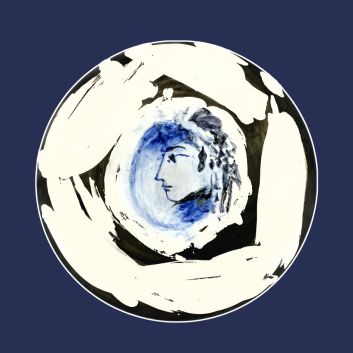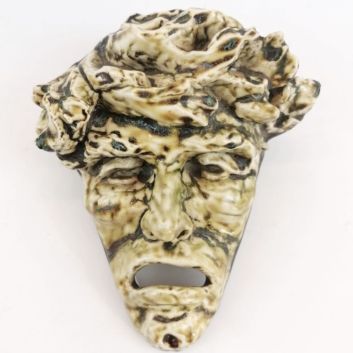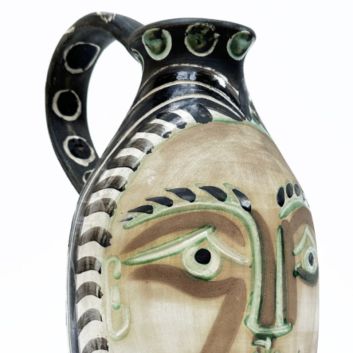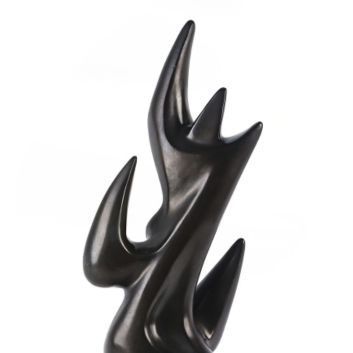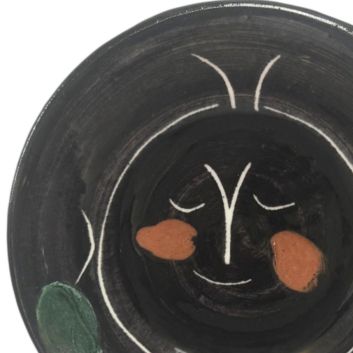Rating and value of Picasso x Madoura dishes

Si vous détenez un plat réalisé par l’artiste Pablo Picasso en collaboration avec l’atelier Madoura ou d’après, et que vous souhaitez connaître sa valeur, nos experts et commissaires-priseurs agréés par l’État vous offriront leurs services d'expertise.
Our specialists will carry out a free appraisal of your work, and provide you with a precise estimate of its current market value.
Then, if you want to sell your work, we'll point you in the right direction to get the best possible price for it.
Rating and value of Picasso x Madoura dishes
Les œuvres qui naissent de la collaboration Pablo Picasso et Suzanne Ramié sont réalisées dans l’atelier Madoura à partir de 1938. L’essentiel de ces œuvres sont en céramique mais on compte également un certain nombre d’œuvres en terre cuite ou en faïence.
Les deux artistes fabriquent ensemble des objets du quotidien, dont des plats, toujours en respectant la tradition provençale. Les plats de cette collaboration sont adjugés entre 3 200 et 37 000€.
Un grand plat circulaire en céramique émaillée bleu dit « Visage », s’est vendu à hauteur de 28 000€ en 2017, tandis qu’il était estimé entre 1 500 et 2 000€, laissant deviner un fort potentiel de hausse pour ces objets.
Order of value from a simple work to the most prestigious
Type of dish | Results |
|---|---|
Plat Toros | From €3,250 to €8,600 |
Bullfighting dish | From €5,100 to €11,050 |
Bullfighting dish | From €3,200 to €22,950 |
Flat face | From €4,300 to €28,000 |
Response in less than 24h
Style and technique of Picasso Madoura's works
A l’atelier Madoura, Picasso et Suzanne Ramié explorent avec fascination des formes anthropomorphes et zoomorphes. Ils façonnent une myriade de créatures, comme des hiboux hiératiques, des oiseaux majestueux ou encore des chouettes, des poissons et de blanches colombes.
Les formes des pichets édités par Madoura sont très diverses, et les matières aussi : terre de faïence, céramique émaillée, terre cuite. Le résultat peut d’une œuvre à l’autre varier du tout au tout, en fonction de l’animal choisi et des couleurs utilisées.
Le style des œuvres Picasso x Madoura se traduit par une fusion entre art et artisanat, où Picasso explore les possibilités expressives de la terre cuite.
Il travaille en série limitées : beaucoup de plats sont édités en séries contrôlées, numérotées et estampillées, avec la participation directe de Picasso dans la création des modèles originaux.
Les motifs qu’il utilise sont récurrents, avec par exemple les visages stylisés, les figures mythologiques, les taureaux, poissons, et oiseaux. Il utilise un langage graphique libre et immédiatement reconnaissable.
Les plats réalisés sont le plus souvent circulaires, avec une composition centrée et une économie de moyens qui a pour but de faire ressortir la ligne, le geste et l’impact visuel.
Il joue avec les engobes et les émaux, expérimentant différentes techniques de décoration : la gravure dans l’argile fraîche, la peinture sur engobe, la réserve, et l’émaillage coloré ou monochrome.
Picasso veille à un équilibre entre la forme et le décor, le dessin ne se contente pas d’orner le support mais épouse parfaitement la forme du plat, permettant de créer un dialogue entre volume, matière et image.
Le style des plats réalisés avec Madoura se situe comme beaucoup d’œuvres de l’artiste dans un style ludique et inventif, reflétant la liberté créative de Picasso, son goût du jeu et sa capacité à transformer un objet utilitaire en œuvre d’art à part entière.
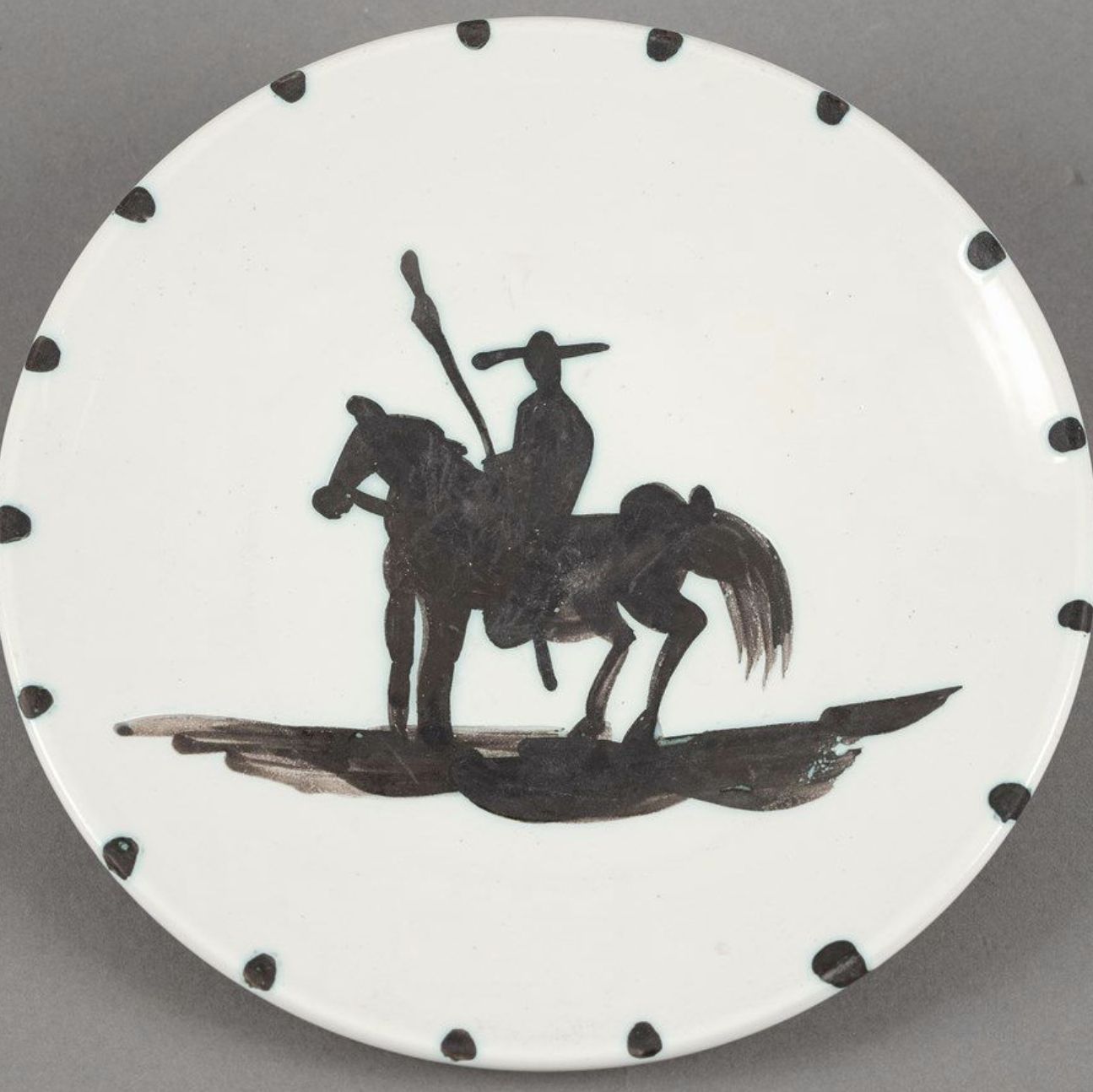

The Madoura studio and collaboration with Picasso
Madoura est un atelier de poterie crée en 1938 par le couple de Suzanne et Georges Ramié, à Vallauris, ville nichée sur les hauteurs entre Antibes et Cannes.
Au cours de ses vacances estivales en 1946, en compagnie de Françoise Gilot, artiste peintre et écrivain, Suzanne Ramié fait visiter l’admirable atelier de poterie de Madoura pour la première fois à Pablo Picasso. Il est émerveillé.
Le couple Ramié l’encourage diligemment à modeler la terre de Madoura, servant sur un plateau d’argent à l’illustre artiste une nouvelle manière d’exercer sa créativité fulminante.
The impact of Picasso x Madoura on their time
Picasso réalise plus de 3 600 pièces en céramique à l’atelier Madoura qui sont le fruit de la rencontre entre Suzanne Ramié et Picasso. Les céramiques de Picasso révèlent une exploration téméraire et une grande spontanéité créative.
Il enquête sans relâche sur l’utilisation de la céramique, aussi bien les secrets de sa technique que de son esthétique. Picasso réussit à faire naître de nouveaux formalismes artistiques qu’il tentait déjà d’approcher depuis sa période cubiste en combinant sculpture, peinture et technique d’impression.
Les objets en céramiques confèrent par le biais de leur troisième dimension un terrain de jeu nouveau pour l’artiste, attribuant une portée sémantique et conceptuelle moyennant sa façon remarquable d’employer la surface et le volume.
Il figure ainsi en trois dimensions ce qu’il avait souhaité communiquer par le biais de ses toiles peintes en l’occurrence sans perspective, sans lois ni règles académiques.
Par ailleurs, ces céramiques nécessitent un grand savoir-faire pour être capable de la peindre sans en connaitre le rendu final, apparaissant une fois la cuisson achevée.
Picasso offre son art à un public nouveau pouvant posséder une œuvre de l’artiste grâce à des prix plus accessibles.
The plates resulting from this collaboration are particularly prized and sought-after for their originality, their decorative aspect and their utilitarian aspect.
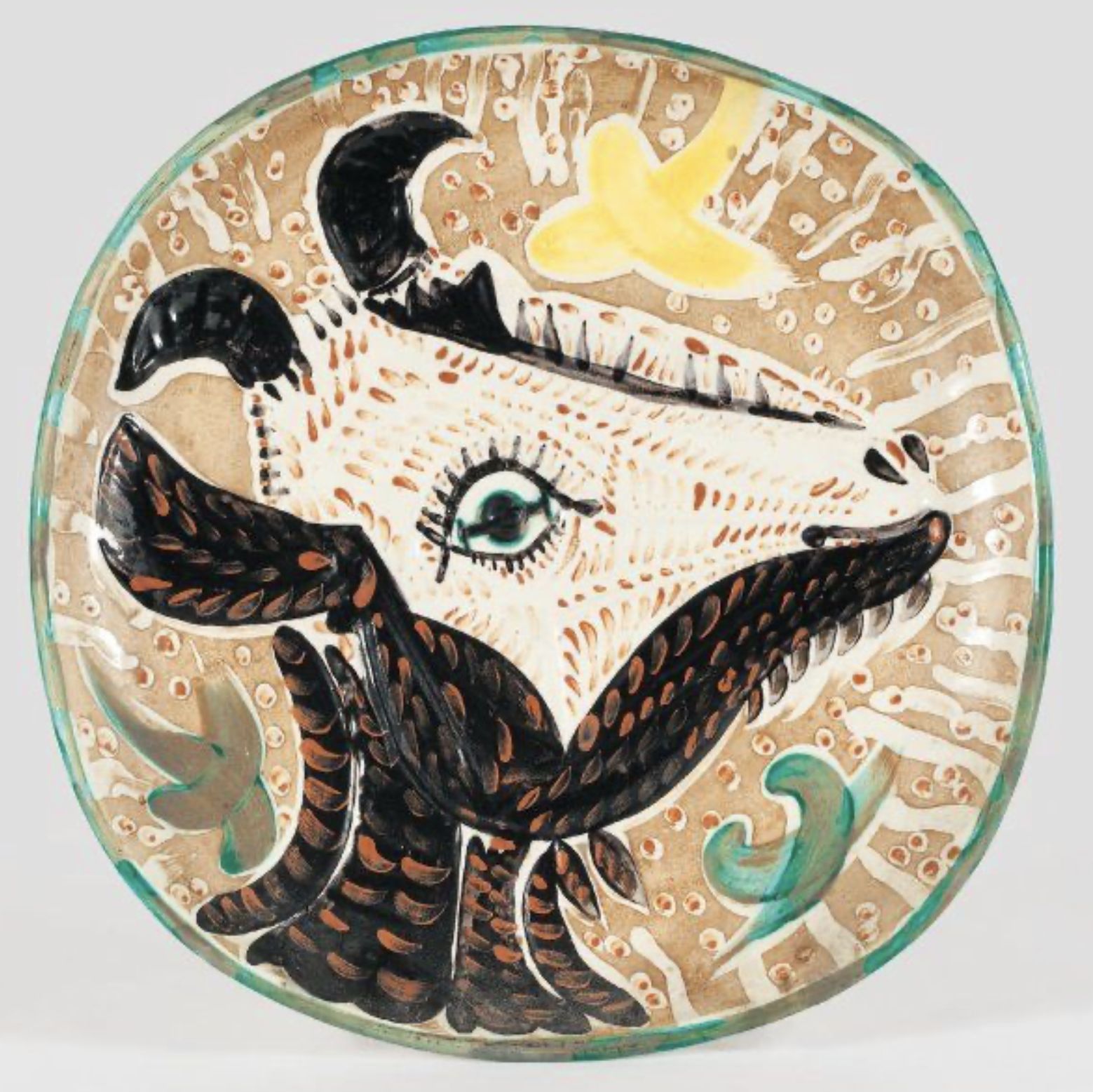
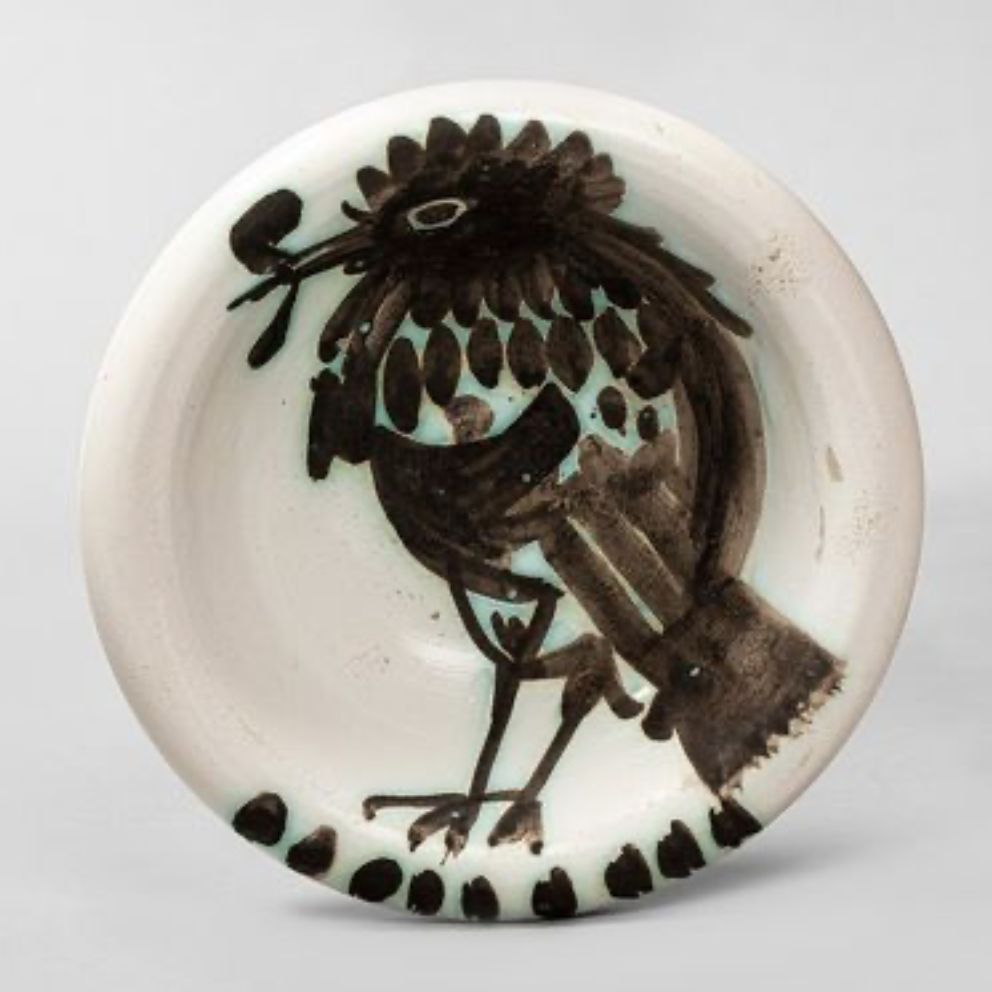
Focus sur Visage noir, Pablo Picasso x Atelier Madoura, 1956, plat en céramique
La composition du plat Visage Noir se veut frontale : il présente un visage stylisé vu de face, avec une sumplicité de traits quasi enfantine, qui donne à l’image une présence expressive immédiate.
Le contraste est marqué entre le fond noir mat du plat, qui met en valeur les lignes blanches gravées dans la terre, créant un jeu d’opposition saisissant entre ombre et lumière.
Le trait est gravé dans l’argile : plutôt que peindre, Picasso choisit la technique de la gravure directe dans la terre encore fraîche, qui permet de donner au dessin un aspect spontané et tactile.
Ce plat est également caractérisé par un minimalisme expressif, quelques traits suffisant à évoquer un visage entier, avec ses yeux, son nez et sa bouche, en démontrant la capacité de Picasso à condenser un maximum de sens dans un maximum de forme.
La symétrie du plat s’en trouve perturbée, étant donné si le visage est globalement symétrique, de légers décalages et irrégularités apportent une tension visuelle qui permet d’éviter tout formalisme.
Ce plat fait partie des objets du quotidien que Picasso élève au rang d’art. Ce plat, utilitaire par sa forme, devient une œuvre à part entière qui mêle sculpture, dessin et design dans un même geste artistique.
L’esthétique est volontairement tribale et archaïque, le visage évoquant parfois l’art africain ou les masques antique, dans une recherche de formes premières et de symboles universels.

The presence of the Madoura workshop on the auction market
Ces céramiques intègrent les foyers et sont très vite prisées par les collectionneurs. Entre 1950 et 1960, de nombreux artistes émérites tels que Marc Chagall, Victor Brauner, Foujita et Matisse défilent tour à tour à La Poterie Madoura.
L’atelier acquiert d’une telle renommée qu’en 1953, on décerne à Suzanne Ramié le titre de Chevalier de la Légion d'Honneur.
Les céramiques issues de l’atelier Madoura acquièrent donc une visibilité internationale, en particulier pour celles réalisées avec Picasso, qui sont très présentes dans les ventes aux enchères en Europe, aux États-Unis et en Asie.
Les éditions signées rencontrent énormément de succès, et les pièces éditées en série limitée sous la supervision de Picasso et estampillées « Maudoura Plein Feu » sont très recherchées, notamment les plats, vases, pichet-hiboux et assiettes.
Le marché propose une grande variété de pièces avec des prix allant de quelques centraines à plusieurs centaines de milliers d’euros, selon la rareté, le sujet et l’état de conservation.
Les céramiques de l’atelier Madoura représentent un certain attrait pour les collectionneurs modernes, ce qui maintient une demande soutenue.
Certaines pièces emblématiques, comme les plats décorés de taureaux, de visages ou figures mythologiques atteignent des records dans certaines ventes XXème.
Le marché des céramiques Madoura (assiettes, pichets, vases), en partie grâce à la notoriété de Picasso et à la qualité de fabrication de l’atelier, est dynamique et stable. Les œuvres Madoura conservent une bonne liquidité et une valeur patrimoniale affirmée.
Recognizing the Picasso Madoura signature
It is important to have your work appraised, as there are unfortunately many counterfeits. The stamp ("édition Picasso Madoura") and the serial number indicate the authenticity of the work.

Knowing the value of a Picasso x Madoura plate
S’il s’avère que vous possédez un plat « Picasso x Madoura », demandez sans hésitation une évaluation gratuite par le biais de notre formulaire sur notre site internet.
A member of our team will contact you promptly to provide you with an estimate of the value of your work, as well as any relevant information about it.
If you're thinking of selling your work of art, our specialists will also be on hand to help you find alternative ways of selling it at the best possible price.
Response in less than 24h
Related topics
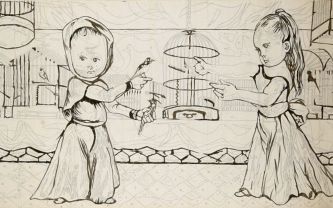
Rating and value of works, drawings, paintings by Léonard Fo...
Léonard Foujita is a twentieth-century Japanese artist who produced a huge number of works, much appreciated and sought-after at auction.
Read more >

Rating and value of works, drawings, paintings by Gustave Ca...
Gustave Cariot was a twentieth-century pointillist painter who produced drawings and oil paintings that were appreciated and quoted at auction.
Read more >

Rating and value of paintings by Charles C...
Charles Camoin is a twentieth-century Fauvist painter who produced works that are highly valued at auction. 24h estimate.
Read more >
Secure site, anonymity preserved
State-approved auctioneer and expert
Free, certified estimates
